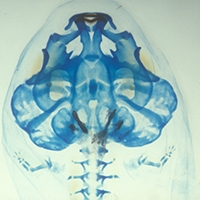Journal Articles and Book Chapters: 2009 - 2000
, 2008. Pickled frogs help biodiversity assessment. In Threatened Amphibians of the World. Barcelona, Gland, Arlington. Barcelona, Gland, Arlington: Lynx Edicions, IUCN, and Conservation International, pp. 45.
, 2008. DNA damage in preserved specimens and tissue samples: a molecular assessment. Frontiers in Zoology , 5.Abstract
, 2008. Gene expression reveals unique skeletal patterning in the limb of the direct-developing frog, Eleutherodactylus coqui. Evolution & Development , 10 , pp. 439-448.Abstract
, 2008. Concealed weapons: erectile claws in African frogs. Biology Letters , 4 , pp. 355-357.Abstract
, 2008. Review of fate-mapping studies of osteogenic cranial neural crest in vertebrates. Developmental Biology , 317 , pp. 389-400.Abstract
, 2008. Segmentation of the vertebrate skull: neural-crest derivation of adult cartilages in the clawed frog, Xenopus laevis. Integrative and Comparative Biology , 48 , pp. 681-696.Abstract
, 2007. Systematics and Conservation. In Amphibian Conservation Action Plan. Gland and Cambridge. Gland and Cambridge: IUCN/SSC Amphibian Specialist Group, pp. 45-48.
, 2007. Montane salamanders from the Costa Rica-Panama border region, with descriptions of two new species of Bolitoglossa. Copeia , pp. 556-565.Abstract
, 2007. Runx2 is essential for larval hyobranchial cartilage formation in Xenopus laevis. Developmental Dynamics , 236 , pp. 1650-1662.Abstract
, 2007. Forelimb-hindlimb developmental timing changes across tetrapod phylogeny. Bmc Evolutionary Biology , 7 , pp. 182.Abstract
, 2007. Cranial ontogeny in Philautus silus (Anura : Ranidae : Rhacoohorinae) reveals few similarities with other direct-developing anurans. Journal of Morphology , 268 , pp. 715-725.Abstract
, 2006. Use of a ROSA26 : GFP transgenic line for long-term Xenopus fate-mapping studies. Journal of Anatomy , 209 , pp. 401-413.Abstract
, 2005. A solution to the large black salamander problem (genus Bolitoglossa) in Costa Rica and Panama. Copeia , pp. 227-245.Abstract
, 2005. Two new species of Pseudoeurycea (Caudata : Plethodontidae) from the mountains of northern Oaxaca, Mexico. Copeia , pp. 461-469.Abstract
